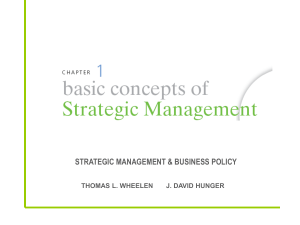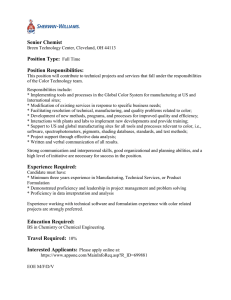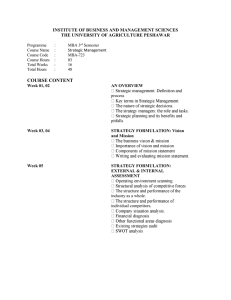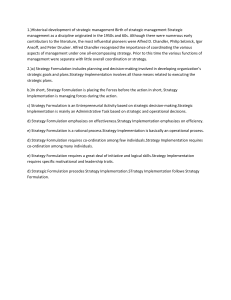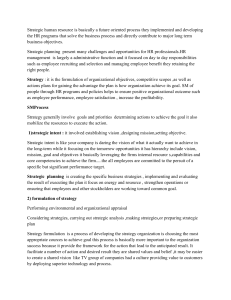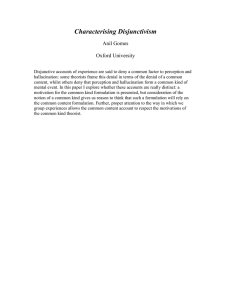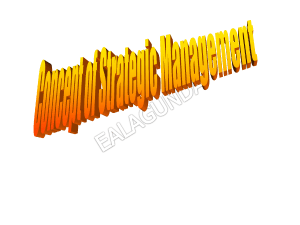Strategic management
advertisement
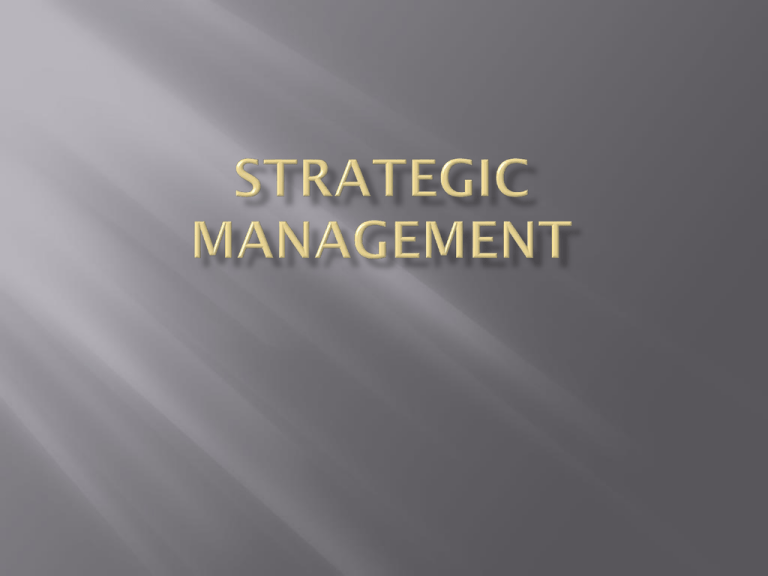
The word ‘strategy’ is derived from a Greek word ‘strategos’, which means generalship----the actual direction of military force Strategy is a plan or course of action or a set of decision rules making a pattern or creating a common thread Strategy is the pattern or common thread related to the organization’s activities which are derived from the policies, objectives & goals Strategy is related to pursuing those activities which move an organization from its current position to a desired future state Strategy is the means to achieve objectives A strategy is a long-term plan of action designed to achieve a particular goal Strategy applies to many disparate fields such as: Military Strategy, Economic Strategy, Environmental Strategy, Corporate Strategy, Expansion, Retrenchment, Merger & Acquisition Strategy etc. Strategy includes the determination & evaluation of alternative paths to an already established mission or objectives & eventually choosing the right alternative Strategies are specific actions suggested to achieve the objectives Strategies are action oriented Everyone is empowered to implement the strategy Strategies are concerned with uncertainties with competitive situation like risk etc. which are likely to take place at a future date Strategy is deployed to mobilize the available resources in the best interest of the company It is the dynamic process of formulation, implementation, evaluation & control of strategies to realize the organization’s strategic intent. It is the set of decisions & actions resulting in formulation, implementation of strategies designed to achieve the objectives & goals of an organization The Strategic management approach emphasizes interaction by managers at all levels of the organization at hierarchy in planning & implementation Strategies formulation activities enhance the problem prevention capabilities of the organization Gaps & overlaps in activities among diverse individuals & groups should be reduced because of the participation in strategy formulation Resistance to change should also be reduced 1. 2. 3. 4. Strategic decision making is the primary task of the senior management Most people agree that decision making is the process of selecting a course of action from among many alternatives. The process is as follows----Objectives to be achieved are determined Alternative ways of achieving the objectives are identified Each alternative is evaluated in terms of its objective-achieving ability & The best alternative is chosen 1. Criteria for Decision Making: There are three major viewpoints regarding setting criteria for decision-making--Concept of Maximization: It is based on the thinking of economists who consider objectives as those attributes which are set at the highest point. The behaviour of the firm is oriented towards achieving these objectives &, in the process, maximizing its returns Concept of Satisficing: This envisages setting objectives in such a manner that the firm can achieve them realistically, through a process of optimization Concept of Incrementalism: According to this, the behaviour of the firm is complex & the process of decision making , which includes objective setting, is essentially a continually – evolving political consensus building. Through such an approach, the firm moves towards its objectives in small, logical & incremental steps 2. Rationality in Decision Making: It means exercising a choice from among various alternative courses of action in such a way that it leads to the achievement of objectives in the best possible manner 3. Creativity in Decision Making: To be creative, a decision must be original & different . A creative strategic decision-making process may considerably affect the search for alternatives where novel & untried means may be looked for & adopted to achieve objectives in an exceptional manner 4. Variability in Decision Making: Given an identical set of conditions, two decision makers may reach totally different conclusions This happens due to variability in decision making It suggests that every situation is unique & there are no set formulas that can be applied in strategic decision making 5. Person-related Factors in Decision-making: There are a host of person related factors that play a role in decision making, such as- age, knowledge, intelligence, risk-taking ability & creativity 6. Individual vs Group Decision–making: Owing to person related factors, there are individual differences among decision maker. As organizations become bigger & more complex & face an increasingly turbulent environment, individuals come together in groups for the purpose of strategic decision making.


